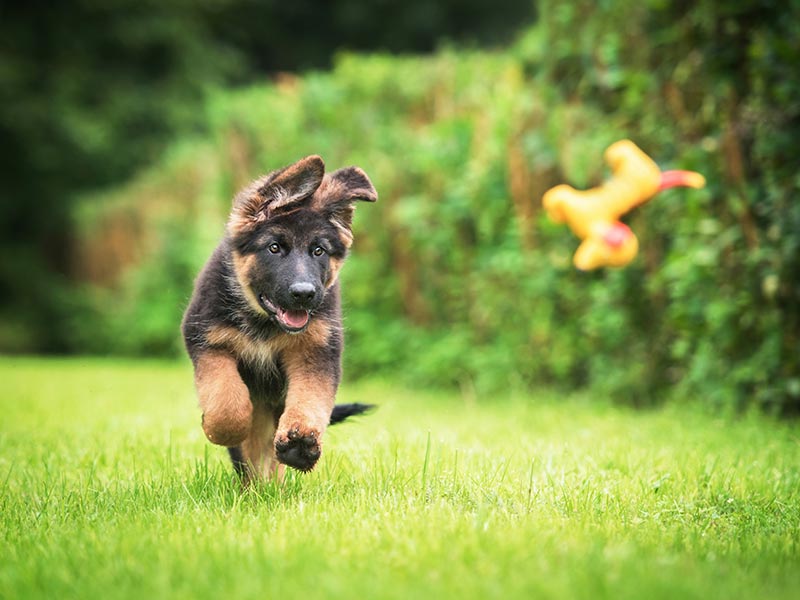5 Steps to a Pet Friendly Lawn

19 July 2021
Our gardens are our pet’s window to the outside world, with many sniffs to smell and places to run. To keep our lawns safe for our four-legged friends there are five simple steps that you can take to make your outdoor space pet friendly.
The 5 simple steps to keeping a pet-friendly lawn are:
- Avoid toxic plants
- Have a fenced-in area
- Use a pet-friendly turf variety
- A mix of shaded and sunny spots
- Use pet-friendly lawn care products
Want to know more?
Step 1 – Avoid toxic plants
Surprisingly, several plants can harm your pets. Their severity ranges from mild rashes, stomach pain, mouth ulcers to vomiting, irritation to the mouth, and convulsions, these requiring urgent veterinary care.
Although most of the time our pets won’t be interested in these plants, it is important to be aware of these plants if they are in your garden.
Some plants that can be toxic for pets include:
- Bird of paradise
- Aloe
- Tulips
- Daffodils
- Most plants with bulbs
- Ivy
- Lilies
- Brunfelsia (yesterday, today, tomorrow)
- Gum trees
- Blue-green algae
- Rhubarb
Step 2 – Have a fenced-in area
Having a safely fenced-in area for your dog to run around in will help stop your pet from getting into mischief.
When installing a fence, you want it to be both practical and look great! There is a variety of options available to suit all budgets, ranging from timber, iron, and wire fencing just to name a few.
If you have an existing fence that is failing to keep your pets inside, walk the boundary and check for any possible escape routes.
Step 3 – Use a pet-friendly turf variety
Humans are not the only ones who love going out and relaxing on the lawn, our pets do too! So, when looking for the best turf variety for your home, it is important to consider not only your needs but your pets too!
TifTuf Hybrid Bermuda is a fast-repairing turf variety. This means if the lawn is going to receive a lot of wear from pets and kids, it will be able to repair itself fast. This turf variety has a soft fine leaf that is great to touch and feels great underfoot.
Sir Walter DNA Certified Buffalo is a hardier grass and performs well in high wear areas. Sir Walter is great with pets and kids, has a soft broadleaf, is low allergenic, and is weed resistant.
Step 4 – Mix of shaded and sunny spots
Having both shaded and sunny spots throughout your lawn is important to keep your pets happy.
On a hot summer day, shaded areas are a great place for our pets to cool off. To help create more shaded areas in your garden you can plant some trees, or even add some furniture that your pets can go underneath.
Sunny areas allow for your pets to soak up the sun on a cool winter day.

Step 5 – Pet-friendly lawn care products
When it comes to using lawn care products, it is important to know if the products you are using around your pets are safe.
Firstly, always read and follow the label’s instructions. If you are unsure of anything, please confirm with your supplier for further details.
Granular fertilisers are safe to use around pets if they are applied as per the application rate and are watered correctly into the lawn/earth. Once this is done, the granules are very difficult to access. But it is always best to keep pets off the lawn for 24 hours after using a granular product on the lawn.
Once a liquid fertiliser has dried and absorbed into the leaf you are fine to let your pets return to the lawn. This can take a few hours depending on the weather.
As chickens will peck into the soil profile, it is best to stick to using a liquid fertiliser.
Avoid using bated products for snails, mice, insects, and other pests as they can be fatal. If your pet does have contact with one of these baited products, seek veterinary advice immediately.
As always, if you have any more questions please don’t hesitate to contact us for free expert advice on 1800ALLTURF (1800255873) or 07 5543 8304.
NOT SURE WHICH TURF TO CHOOSE?
Contact us for expert advice, or come & checkout our lawn display at Tamborine


